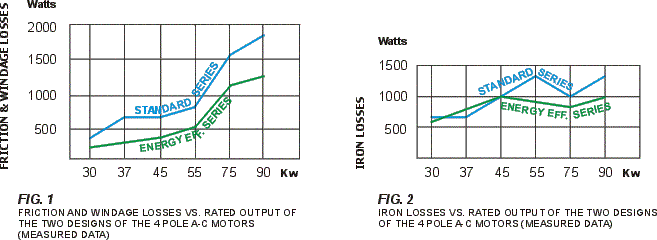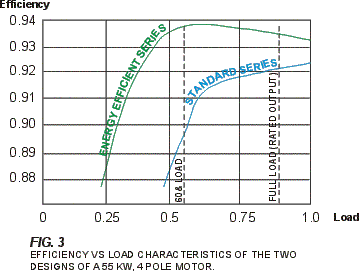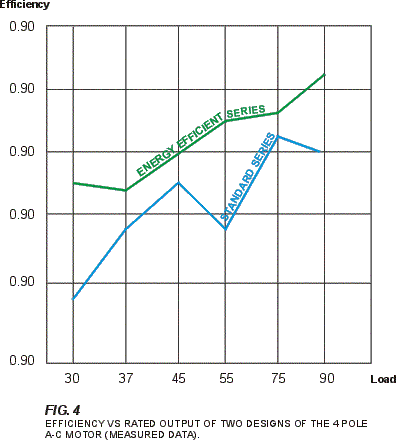Motor efficiency consideration
Motor efficiency is a measure of the effectiveness with which a motor converts electrical energy to mechanical energy.
It is defined as the ratio of power output (On the shaft) to power input (From the mains).

Every AC motor has five kinds of watts losses:
Stator "I2R" losses
Rotor "I2R" losses
Stray load losses
Iron losses
Friction and winding losses
The first three kind of losses depend on the current flowing throuth the motor winding, the last two are constant. All watts losses of the motor are converted
into heat which is dissipated by the motor aided by an external fan.
Improving efficiency by minimising the powere (Watts) losses
The improvement in motor efficiency can be obtained by proper motor design.
There are basically two different strategies that can be followed in striving to imporve the efficiency of
the motor and reducing the electrical and magnetic loadings in it. This is a very easy method, and
motors of this type are being marketed by several companies in the USA and Wurope.
But this main disadvantages are the increased cost and weight of the motors.
The second approach is to optimise the motor design and particularly to change the efficiency vs. load
characteristics of the motor, with a minimum increase in the motor weight and cost.
The latter strategy has considerable advantages for both the manufacturer and the user.
The motors of such a design require a redistribution of motor losses, the constant losses must
be minimised to the lowest possible level.
Improving efficiency by minimising the watts losses
The motors of a nre series "DK" are designed acc. to the latter described above methods.
Winding losses are reduced by optimising both the shape and the dimensions of the external fans, iron losses
are kept low by an optimally designed magnetic circuit. The winding losses and the iron losses of the motors of the new energy efficient series compared with standard series motors
are displayed in Figure 1 and Figure 2.

The efficiency Vs load characteristics of both designs of a mean (55Kw, 4 pole) induction
cage motor are shown in Figure 3. The maximum efficiency of an energy efficient motor is
about 75 per cent of full load, for a typical standard motor the maximum is usually about full
load. However, detailed surveys have shown that the average operation load of industrial motors is
only about 60 per cent off full load. Figure 3 shows the fall off in efficiency at this loading.
But the efficiency at this loading is considerably higher for an optimised, energy efficient motor than for
typical standard design.

Figure 4 compares the efficiency of the newly designed motors of the energy efficient series DK with the efficiency of standard motors.
The most important benefit of the improved efficiency motors is their reduced electricity consumption.
But the reduced losses result in a lower operating temperature than that of the equivalent standard AC motor.
The motors of the series DK run on average some 10 deg. C. than standard induction motors.
This prolongs the life of the motors roughly doubling the insulation life. The motors can better withstand overloads of any kind.

Energy saving calculation
A mean motor of the energy efficient series DK, 55Kw, 4 pole operating at 60 per cent of full
load, has its efficiency about 3.5 per cent higher than a standard motor. The user of this
energy efficient motor saves at two shifts operation (400 running hours per year):
55 x 0.6 x 0.035 x 4000 = 4620 kWh per year


